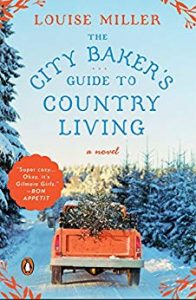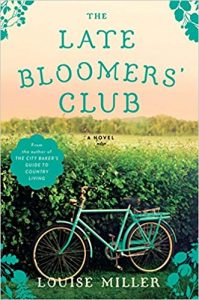Interview with Louise Miller, author of The Late Bloomers’ Club
Interview with Louise Miller, author of The Late Bloomers’ Club
By Jennifer S. Brown
 If your mouth watered as you read of the amazing pies made by Livvy in The City Baker’s Guide to Country Living, then you won’t be surprised to hear that the book’s author, Louise Miller, is a pastry chef in real life. If you follow her on Facebook , Instagram or Twitter (and you should), you will be tantalized with photos of her gorgeous sweet treats. You’ll also discover another interesting fact about Louise: Though she’s a city girl—she lives and works in Boston—she’s minorly obsessed with goats. Seriously.
If your mouth watered as you read of the amazing pies made by Livvy in The City Baker’s Guide to Country Living, then you won’t be surprised to hear that the book’s author, Louise Miller, is a pastry chef in real life. If you follow her on Facebook , Instagram or Twitter (and you should), you will be tantalized with photos of her gorgeous sweet treats. You’ll also discover another interesting fact about Louise: Though she’s a city girl—she lives and works in Boston—she’s minorly obsessed with goats. Seriously.
I think these two things are part of what make Louise such a wonderful writer. The attention to detail required to make Meyer Lemon Bars or Blueberry Pate de Fruit is the same attention she applies to her writing. In both City Baker and her new book, The Late Bloomers’ Club, the rural town of Guthrie, Vermont, is so alive as to be a character itself. The details of the residents, the businesses, the lush beauty of the surroundings will have you longing to visit. It will come as a surprise to most readers to know that the town doesn’t exist; Louise has painted such a thorough picture, though, that it feels as real as your hometown.
As for the goats, it’s a little surprising, this citified author who’s crazy about those ruminant mammals. Likewise, her novels are filled with characters who have unexpected aspects to their personalities. No cookie-cutter characters in a Louise Miller novel. Each is fully realized and written with depth, and their quirks and habits bring them to life. They may not be goat lovers, but they are interesting in their own ways.
I was lucky enough to read an advanced copy of The Late Bloomers’ Club and I was smitten by the story of Nora, the owner of the Miss Guthrie Diner who suddenly inherits—with her free-spirited sister—a large chunk of land. Should she sell it to the big-city real estate developers and solve her and her sister’s financial woes? Or maintain Guthrie’s small-town feel and hold onto the land? The town residents are divided and the more Nora tries to make a decision, the more muddled it gets as she learns secrets about the house’s original owner, finds herself attracted to the real estate representative and desperately tries to find a missing dog.
Because I know Louise through the Boston writing community, I was lucky enough to be able to sit down with her and ask her about her latest book and her writing life. Here’s what we discussed.
 In City Baker’s Guide to Country Living, Livvy leaves Boston to work as a baker at the Sugar Maple Inn in Guthrie, Vermont. You decided to return to the town of Guthrie for The Late Bloomers’ Club where Nora owns the Miss Guthrie Diner, even though this novel is not a sequel. What are the challenges of setting the novel in the same town? Will we see Guthrie in future novels?
In City Baker’s Guide to Country Living, Livvy leaves Boston to work as a baker at the Sugar Maple Inn in Guthrie, Vermont. You decided to return to the town of Guthrie for The Late Bloomers’ Club where Nora owns the Miss Guthrie Diner, even though this novel is not a sequel. What are the challenges of setting the novel in the same town? Will we see Guthrie in future novels?
One of the great joys of writing The City Baker’s Guide was creating the town of Guthrie. The map of the town is imprinted on my brain. The City Baker’s Guide was the story of an outsider making Guthrie her home. I thought it would be fun to see the same place from the opposite angle—the main character of The Late Bloomers’ Club, Nora, was born in Guthrie and never left. It was a pleasure to return to the town. I think the biggest challenge was to make sure I included enough detail to make the town feel alive to new readers, but not so much that I would bore the readers of The City Baker’s Guide with information they would be familiar with.
My current project is not set in Guthrie, but I would love to return to it again!
The book world sometimes feels like it’s all about the debut. How was writing and publishing a second novel different than your first?
When I sold my debut, it was in a 2-book deal. In some ways, my writing process was the same. I tend to like to write my first draft privately, and then get feedback when it is time to revise. It definitely was challenging to me to write on a deadline—the pressure!—but I am grateful that the pressure pushed me through my “sophomore slump” fears, and it helped me let go of the business stuff and get back to being creative. The major difference was that I workshopped the first novel in a year-long program, and had a lot of feedback. For The Late Bloomers’ Club my partner was my first and only reader before I started working on it with my editor.
Another challenge was that there was a lot more overlap of the business end of publishing with the creative part—I was still working on the manuscript while discussing cover, title and catalog copy, so that was different. And yes, there is a lot more attention paid to debuts, so that is challenging. But I have to say there has been a lot less anxiety the 2nd time around. I really like knowing the publishing process, and what to expect and when. And it was lovely working with the same team.
In Late Bloomers’, Nora owns a diner, and your fans know that you have a lot of experience working in kitchens. However, Nora’s sister, Kit, is a filmmaker, of which I don’t believe you have first-hand experience. What kind of research did you have to do to create her character?
I based some of Kit on people I knew in art school, and I leaned heavily on my film-making friend Jim Picariello, who was there to answer the detail questions about equipment and festivals.
This book has a number of threads seamlessly woven together (a big box corporation encroaching on small town life, a possible romance, a missing dog, a new cake business, and even more…). When you’re writing, how do you keep track of the various storylines? Are there any storylines you enjoyed writing more than others? Which of the storylines was the most challenging for you?
I’m so glad to hear they are seamless! I was sure when I turned the book in that my editor was going to ask me to cut at least 2 subplots out of the book, and I was thrilled when she didn’t! When I am writing my first draft, I actually don’t keep track, which is a little crazy, but I like to see what happens organically, knowing I will tinker in revision. Once the story is down, I break the book down by scene, and color code all of the characters and subplots and themes—that’s when I start to look at it critically, and make sure nothing has dropped off or is underdeveloped.
I actually loved all the storylines equally, but I especially loved working on the scenes with Max, who was a delight to write.
Art features predominantly in the novel, both paintings and sculptures. What was your inspiration for the pieces you describe in the story? Do you have an artistic bent beyond writing? Who are your favorite artists?
I’ve always been drawn to outsider art, and the sculptures in the book were inspired by an exhibit I saw decades ago—I wish I could remember the name of the artist. I do have many artistic bents! I actually went to art school in the late 80’s/early 90’s, to study photography. I love art of all stripes. One of my favorite artists is the sculpture Charles Ledray. We went to an exhibit of his where he created a miniature thrift shop, hand sewing all of the clothes, making wire hangers and even the dust that was above the drop ceiling of the store. I tend to love obsessive artists. Like the filmmaker Wes Anderson. The artists who obsess over—and take obvious pleasure in—the little details. There is something about that level of attention and effort that I find thrilling.
For myself, writing is my main form of expression, but I love to play banjo, and draw, and I make pastry for a living. I’m dying to learn to paint. And I want to learn printmaking. And illustration. And I secretly want to act. And I’ve always wanted to make a movie. Basically, if I could spend the rest of my life in art school I would do it. Is there anything better in life than making things?
City Baker’s was all about the pie. Late Bloomers’ revolves around cake. What’s your favorite dessert? Do you have more desserts to tackle in future books?
My favorite dessert is apple pie, seconded by ice cream. I love ice cream. And cookies. Okay, I love sweets. My current project doesn’t have a dessert focus, but there is food!
People who follow you on Twitter or your Facebook author page know you have a special fondness for goats. What is up with the goats?
They are as sweet as dogs! And they are very bouncy. I can still remember petting my first dairy goat in the early 90’s at the Topsfield Fair, and the way he leaned his head into my hand and gazed at me. It was love at first sight! And have you ever held a baby goat and had it fall asleep in your arms? Heaven.
Louise Miller is a writer and pastry chef living in Boston, MA. Her debut novel, THE CITY BAKER’S GUIDE TO COUNTRY LIVING was selected as an Indie Next pick by the American Booksellers Association, a Library Reads pick by Librarians across the U.S., and was shortlisted by the America Library Association’s Reading List Council for best women’s fiction in 2017. Her 2nd novel is THE LATE BLOOMERS’ CLUB. In addition to being a writer and baker, Louise is an art school dropout, an amateur flower gardener, an old-time banjo player, an obsessive moviegoer, and a champion of old dogs.
Jennifer S. Brown has published fiction and creative nonfiction in Fiction Southeast, The Best Women’s Travel Writing, The Southeast Review, and Bellevue Literary Review, among other places. She holds an MFA in creative writing from the University of Washington. Her debut novel, Modern Girls (NAL/Penguin), set in 1935 in New York City, is about a mother and daughter who must face the consequences of unplanned and unwanted pregnancies. Connect with her at www.jennifersbrown.com and http://twitter.com/j_s_brown.
About THE LATE BLOOMERS’ CLUB
 A delightful novel about two headstrong sisters, a small town’s efforts to do right by the community, and the power of a lost dog to summon true love
A delightful novel about two headstrong sisters, a small town’s efforts to do right by the community, and the power of a lost dog to summon true love
Nora, the owner of the Miss Guthrie Diner, is perfectly happy serving up apple cider donuts, coffee, and eggs-any-way-you-like-em to her regulars, and she takes great pleasure in knowing exactly what’s “the usual.” But her life is soon shaken when she discovers she and her free-spirited, younger sister Kit stand to inherit the home and land of the town’s beloved cake lady, Peggy Johnson.
Kit, an aspiring–and broke–filmmaker thinks her problems are solved when she and Nora find out Peggy was in the process of selling the land to a big-box developer before her death. The people of Guthrie are divided–some want the opportunities the development will bring, while others are staunchly against any change–and they aren’t afraid to leave their opinions with their tips.
Time is running out, and the sisters need to make a decision soon. But Nora isn’t quite ready to let go of the land, complete with a charming farmhouse, an ancient apple orchard and the clues to a secret life that no one knew Peggy had. Troubled by the conflicting needs of the town, and confused by her growing feelings towards Elliot, the big-box developer’s rep, Nora throws herself into solving the one problem that everyone in town can agree on–finding Peggy’s missing dog, Freckles.
When a disaster strikes the diner, the community of Guthrie bands together to help her, and Nora discovers that doing the right thing doesn’t always mean giving up your dreams.
Category: Interviews, On Writing



